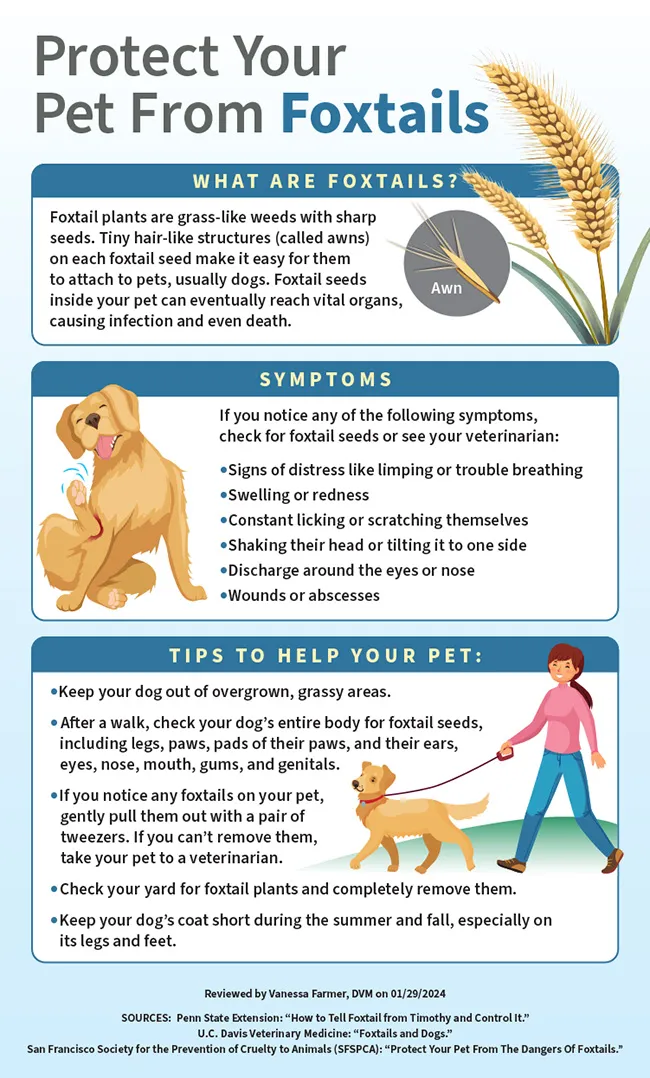As you enjoy a walk or hike with your dog, be aware of foxtail grasses, which are weeds with sharp tips that dogs can step on, brush by, or inhale. Foxtails thrive in a variety of environments throughout the U.S. Because of their pointy shape, they can embed themselves inside your dog’s body and cause injury.
What Is a Foxtail Plant?
The foxtail plant grows in the spring, reaches full bloom in summer, and dies in the fall. The grasslike weed is mostly found in the western half of the U.S. but can be a risk for pets in any state.
Foxtail seed
Foxtail seed heads are usually upright, but some can droop downwards. They’re mostly green and yellow. Another identifier is their tiny hairlike structures, known as awns, coming off each seed.
Each year, foxtail plants drop hundreds of seeds into the earth, and they harden as they dry out. Once stepped on, the barb-shaped seeds hook into your dog’s skin. The sharp awns can work their way into any part of your dog’s body, including their nose, eyes, ears, and mouth, causing serious damage.
What Do Foxtail Plants Look Like?
Foxtails look a lot like a fox’s bushy tail; that’s where the name comes from. Look for a fluffy tail at the top of the plant with hairlike strands (the seed head). All types of foxtail plants have fibrous roots, and they grow together in clumps. You’ll find them in areas with full sunlight, as they don’t do well in shady areas.
Foxtails exist in several varieties, with three main types: Giant, Green, and Yellow foxtails. Sizes of these foxtail plants vary:
Giant foxtails grow 2-4 feet tall and have the largest seed head, about 1.5-8 inches long, which tends to droop downward.
Green foxtails grow 1-2 feet tall and may have a seed head as large as the giant foxtail, but it stays upright.
Yellow foxtails grow 1-3 feet tall and have the smallest seed head of these three species, about 0.75-6 inches long, which stays upright.
In addition to spotting the fluffy top of the plant, the seeds, and colors, look at the structure closely -- specifically the ligule, which is a thin outgrowth that you’ll find on the collar of the plant, where the leaf and leafstalk meet. Here you’ll find a hairlike structure. It looks a bit like a fine fringe.
Where are foxtails found?
Predominantly found out West, foxtails exist throughout the U.S. in parks, meadows, flatlands, and other grasslands. In agriculture, foxtails are the second most common weed among broadleaf crops, fruits, and vegetables, according to the Weed Science Society of America.
Why Are Foxtails Dangerous for Dogs?
Foxtail seeds can lead to serious infection once inside your dog’s body because they don’t break down. Embedded foxtails can cause discharge, abscesses, swelling, pain, and even death.
The most dangerous exposure is when dogs inhale a barbed seed. This can happen if your dog runs with its mouth wide open in a field of foxtails. Inhaled foxtail seeds can wind up in the lower airways of your dog's lungs. Fortunately, this is rare.
The seeds can also enter your dog’s body through their skin since they’re hard to find in your dog’s fur. Your dog can step on the seeds or even brush by the plant without you realizing it. The seeds must be removed to prevent any pain or injury to your pet.

Foxtails and Your Dog: Risks and Symptoms
Foxtails can dig through your dog’s skin or be inhaled through its nose or mouth. The spiked seeds then travel through your dog's body and can move to its brain, lungs, and other organs. If your dog shows signs of distress, such as limping or trouble breathing, or if you notice any of the following symptoms, check for foxtails or see your veterinarian:
- Paws: Foxtail seeds fall to the ground, and your dog can easily step on them. Once that happens, the seeds can embed themselves between your dog’s toes. Check for foxtails if you notice swelling or limping or if your dog is constantly licking their feet.
- Ears: If you notice your dog shaking his head, tilting it to the side, or scratching nonstop at their ear, it could be a sign of an embedded foxtail. The seed can move deep inside your dog’s ear canal making it impossible to detect without your vet's help.
- Eyes:Look for redness, discharge, swelling, and your dog squinting and pawing the area. It may mean that a seed has lodged itself inside your dog’s eye.
- Nose:If you see any discharge from your dog’s nose, or if your dog is intensely and frequently sneezing, a foxtail may be lodged in your dog’s nasal passage.
- Genitals:Foxtails can find their way inside your dog’s genitals, too. If your dog is persistently licking the area, it could be a result of foxtails.
- Skin: If you notice any wounds or abscesses on your dog’s skin, it could be from a foxtail seed.
How to Remove Foxtails From a Dog
If you notice a foxtail seed on your dog, remove it using tweezers in the same manner as removing a tick, before it burrows in. If you don’t know how to do this or if you suspect the foxtail is already embedded inside your dog’s body, take them to the veterinarian.
Tips for Preventing Foxtail Problems
Any dog can get foxtails in the ears, nose, eyes, or mouth. But dogs with long ears and curly hair can be especially prone to foxtail problems. Be sure to:
- Avoid walking your pet in areas where you know foxtails grow; keep your dog out of overgrown, grassy areas.
- If you find yourself unexpectedly around foxtail plants, keep your dog on a leash away from the foxtails.
- Just like with ticks, after a walk, check your dog’s entire body to make sure you don’t find any foxtail seeds. This includes the usual places such as your dog’s legs, paws, pads of their paws, ears, eyes, nose, mouth, gums, and genitals. If you notice any foxtails, gently pull them out with a pair of tweezers.
- Check your yard for foxtail plants and completely remove them, roots and all.
- Keep your dog’s coat short during the summer and fall, especially on its legs and feet, because foxtails can get caught in your dog’s fur.
Cats can get foxtails, too
If you have an outdoor cat, check them when they come inside. Foxtails aren’t usually found in a cat’s nasal cavity because they're too small. However, cats can step on foxtails, which can be found on other parts of your cat’s body.
Takeaways
The problem with foxtails is that they are not always easy to detect. If you suspect your dog has an embedded foxtail seed, take him to the veterinarian for a full body checkup to help prevent a serious injury. Your best bet to keep your dog safe from foxtails is to avoid areas where they grow.
Foxtail FAQs
What are foxtails in dogs?
Foxtails contain razor-sharp seeds that can embed themselves into your dog’s body. They can enter your dog’s mouth, nose, eyes, ears, paws, genitals, and fur.
Where do foxtails grow in the U.S.?
You can find foxtails in grasslands, parks, and meadows throughout the U.S.
What kind of grass produces foxtails?
Foxtails are part of the Poaceae grass family. There are three major types of foxtail plants. They are Giant foxtail, Green foxtail, and Yellow foxtail.
How do you get rid of foxtails on a dog?
If you spot a foxtail sticking out of your dog’s body, use tweezers in the same manner as if you were removing a tick. If the foxtail is embedded in your dog’s body, take him to your veterinarian immediately.


